On third day of bicycle trip in Angkor Archaeological Park, I covered the Roluos Group of Temples that include Preah Ko, Bakong and Lolei Temples, and then also visited the Angkor Park main area to cover other temples like Banteay Samre, Ta Prohm, Ta Keo and Thommanon during the entire day. All the temples on my radar to cover on the third day are scattered at quite large distances from each other, so it required about 80 kms of cycling on that day. At the end of the day, I covered all the places from my list and also spent one hour watching magnificent Angkor Wat Temple during the sun set.
I started early in the morning and moved along Siem Reap-Phnom Penh National Highway towards the Roluos Group of Temples. These temples are approximately 15 kms away from Siem Reap City. There were few tourists also cycling on the highway, so it was not a kind of crazy trip as it was in the case of Banteay Srey. Three main temples of Roluos Group are Preah ko, Bakong and Lolei Temples and they are situated on the both side of the highway. Lolei is on the left hand side, and the other temples are on the right side of the highway while approaching from Siem Reap.
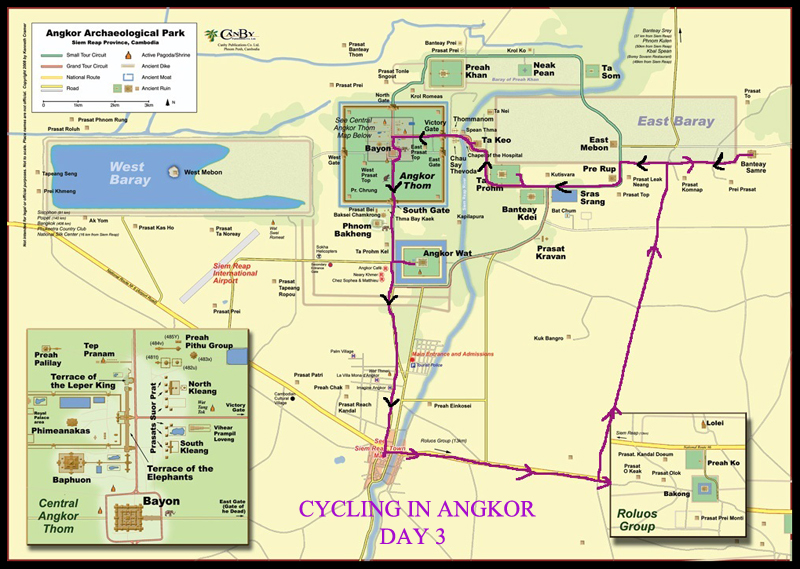
I first reached at the junction of link road going on the right hand side towards Preah Ko and Bakong from the highway near Lolum. On that link road I moved for about 500 meters and reached at the entrance of Preah Ko.
Preah Ko: Preah Ko, also known as the temple of sacred bull due to the statue of three Nandi Bulls located outside each of its three front-side prasat. These statues of Nandi Bull indicate that this temple was might be dedicated to Lord Shiva. This temple was enclosed with two boundary walls, from which some part of the outer enclosure wall is still survived. On a raised platform there are six prasats, three at the front side and three at the back side. Front-side prasat towers are bigger than the three backside prasat towers and among all these six, the front-side central prasat tower is the largest. The outer walls of these prasat towers are highly decorated by lime mortar and stucco are still visible at many points. The stucco decoration and lintels carvings on these prasat are considered as the most beautiful among the all Khmer artistic production.
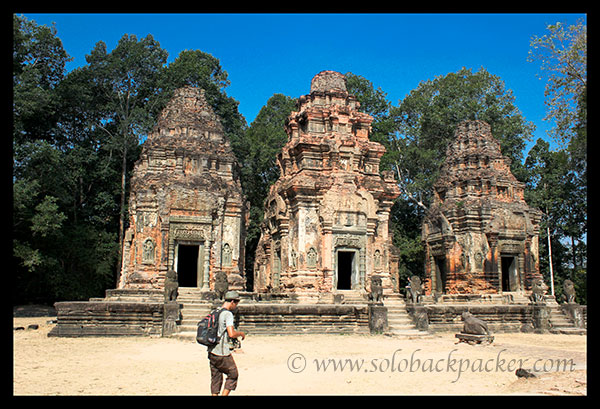
Bakong: This is situated about 800 meters further from Preah Ko. This magnificent temple is considered as the finest example of the temple mountain. It is the official temple mountain of city of Hariharalaya. This temple is constructed at five different levels and top of these , in the center, is its central prasat in the shape of an almost square pyramid. This central prasat represents Mount Meru, while five different levels represent the five gods, nagas, garudas, rakshasas, yakshas and devas, of the Vedic mythology. Bakong is one of the most beautiful temple visited by me in Angkor Archaeological Park.
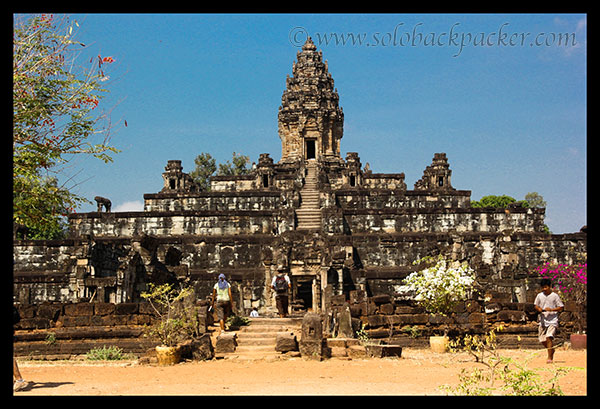
Lolei: Lolei Temple is situated on the left side of the National Highway 6, while approaching from Siem Reap. From the junction of the link road going towards Preah Ko and Bakong, move a little ahead (approx. 400 mtrs) on the highway and then turn left towards Lolei Village on the bad-conditioned link road for approx 500 mtrs in order to reach this temple. This temple was built by Yashovarman I in 889 in memory of his father Indravarman and his royal ancestors.

This temple was once located on an artificial island, in the middle of a lake, which is dry now. The temple is still situated on a raised platform from the level of the road leading to this location. The temple prasat contains four brick towers, those are not in very good condition now. But, the stucco decoration and carvings on the outer wall of the towers are clearly visible on the remaining parts.
Moving Towards Banteay Samre: After visiting Lolei Temple, I moved towards Siem Reap again. My intention was to find a suitable approach road for Banteay Samre, which is located in an isolated place inside the main Angkor Archaeological Park area. After about 6 kms ride along the main highway, I saw a board on the right side indicating the direction of the Angkor Park. I moved on that road (Road 67 going to Pradak) and that journey seemed too long (about 12 kms) under the bright sun rays and hot weather. This well-paved road passed through many paddy fields, surrounded by coconut trees and gave me an experience of the rural side of Cambodia. The landscape around the road was amazingly beautiful and despite of the scorching sun rays and heat, it was really a visual delight to see the beautiful paddy fields full of water around me.
I also noticed many roadside petrol and diesel selling stalls, who sell these items in the wine bottles. There is no guarantee of the purity and price, but in Siem Reap, where finding a petrol pump is rather difficult, those shops play a major role during the crisis on the road.
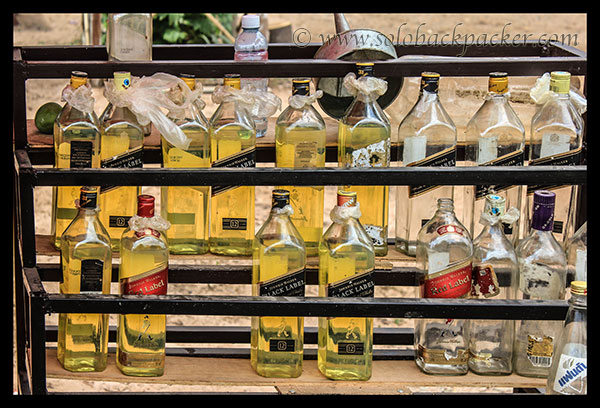
And, while moving on that Road 67, I came to know about the fact that shopkeepers in the park area were charging us the prices at least 4-5 times higher than the actual price of water bottle and Coke can. I mean 2-3 times is understandable as prices are inflated at every tourist place, but 4-5 times for items like water and Coke! it was crazy. In a bright sunny day in that hot weather, we require a lot of water to survive in the Angkor Park Area and for each bottle we have to pay at least 4 times higher than the actual prices 🙂 . When, I purchased water and Coke on that road to Banteay Samre, from a shop, which was outside the park area and the girl at the shop seemed innocent enough to inflate the price, I got them at very cheap rates.
However, on the last day of stay in that area, inflated prices was not a matter of concern and I moved ahead to Banteay Samre.
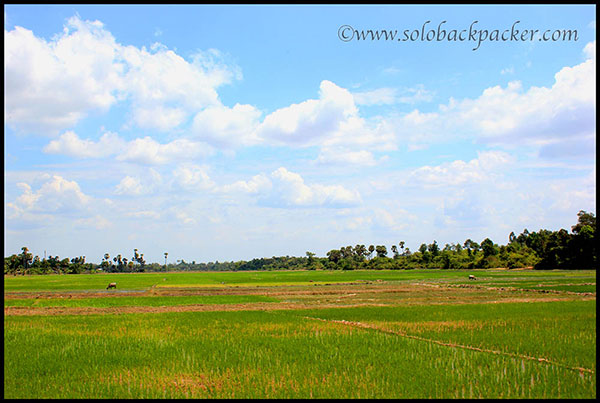
Approach route to Banteay Samre is very scenic. I can say it is the most beautiful in all park areas. The road is covered by green coconut trees at both side with beautiful houses and farm fields along the road. Mango Trees were also there in plenty and so are the paddy and vegetables fields. I parked the bicycle along the dirt track approaching towards the temple. There I saw a rope on the road segregating the temple area from the rest of the areas. When I asked a shopkeeper about that marking, she informed me that shopkeepers and hawkers are not allowed beyond that point, so that tourist can enjoy their visit without any disturbances.

Banteay Samre: Banteay Samre literally means the Citadel of Samre. Samre are considered as the ancient people of Indochina, who basically lived around the area of present day Phnom Penh. The location of this temple is rather isolated from the other temples of Angkor Archaeological Park, but this temple can also counted among the most beautiful temples of this park. This temple is circled by two enclosures and both are still in excellent condition. This temple is one of the most preserved temples of the Angkor Park. Beautiful stucco and stunning carvings are visible on the wall of this temple. The beautiful columns of the windows in the inner as well outer walls of this temple give it a remarkable look. The scenes from Ramayana can be found at the south gopura on the pediment on the outside of the outer enclosure wall.
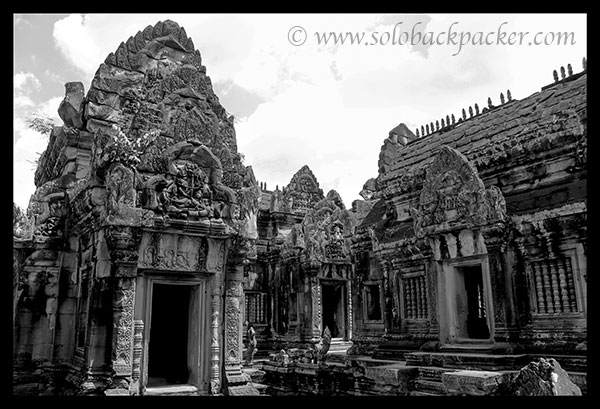
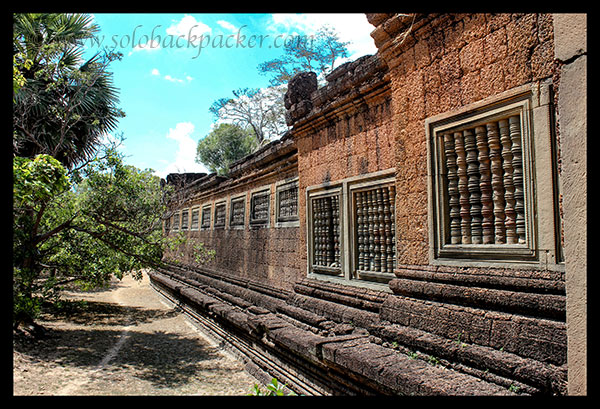
After visiting Banteay Samre, I moved towards to Srah Srang in order to reach Ta Prohm. I kept moving along the lake at Srah Srang, and along the outer enclosure of Banteay Kdei, and finally reached to one of the most exciting destination of Angkor Archaeological Park, that is Ta Prohm (about 11 kms from Banteay Samre).
Ta Prohm: This is one of the most popular temple complex in Angkor park, so it always remains packed with tourists. This temple is famous for the massive trees grown over the ruins of the temple. The roots of these trees hold the ruins of these temples in a remarkable way. It is also popular because of its place in Angelina Jolie’s movie Lara Craft: Tomb Raider. The temple gives a jungle-like feel as many of the portion of this temple left untouched and covered with massive roots of large trees. Ta Prohm literally means the Temple of Brahma The Ancestor, but believed to be built by Jayvarman VII in 1186 as a Mahayana Buddhist Monastery and University. Unlike other popular temple of Angkor Park, which are built in typical pyramid or mountain like style, this temple is built in a typical flat Khmer style. Archaeological Survey of India is a major partner in the restoration work of this temple with APSARA (Authority for the Protection and Management of Angkor and the Region of Siem Reap).
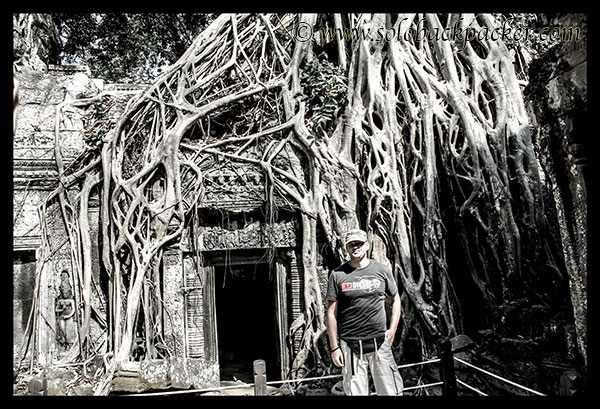

Ta Keo: About 2 kms from Ta Prohm towards the Victory Gate of Angkor Thom, this temple is built at two levels enclosed by a boundary wall. It is again built like a pyramid structure, on the top of which is a central prasat tower, surrounded by four corner prasat towers. This temple is one of the unfinished temples of Angkor Archaeological Park.
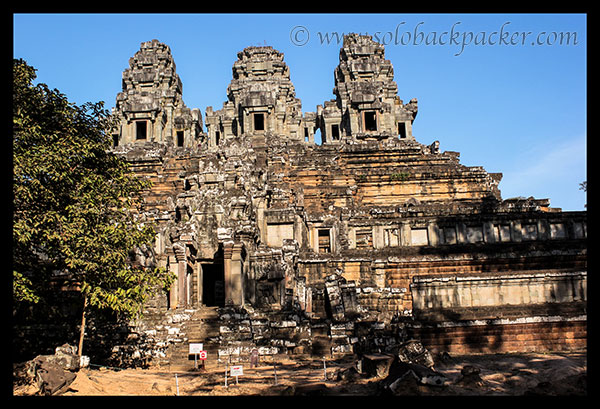
Thommanon: This temple was the last temple visited by me on the third day. Thommanon is located between Victory Gate of Angkor Thom and Ta Keo Temple, about 500 mtrs from the Vicotry Gate and is nearly 1.5 kms from Ta Keo.

After visiting these temples at the third day, I entered in Angkor Thom through the Victory Gate. I spent some time around the Terrace of the Elephants and the Terrace of the Leaper Kings and then moved to Phnom Bakheng to watch the spectacular sunset at Angkor Archaeological Park. By the time, I reached Phnom Bakheng, it was very crowded and entry to the hill was closed by the tourist police. So, I did not get a chance to go on the hill and moved further to the Angkor Wat Temple.
Evening at Angkor Wat Temple: There were already many people sitting on the stairs along the moat (water channel) outside Angkor Wat Temple. Still 30 minutes were left for the sun set, so I also parked my bicycle and sit on the stairs. The whole scene turned in to a fair-like atmosphere with the increasing number of tourists. It was like a party-time outside Angkor Wat Temple. The temple looked very beautiful during the sun set and then there was no regret missing the sunset from Phnom Bakheng. When it started getting dark, that party came to an end. Everybody left the stairs and started moving back towards Siem Reap with their respective vehicles or bicycles.
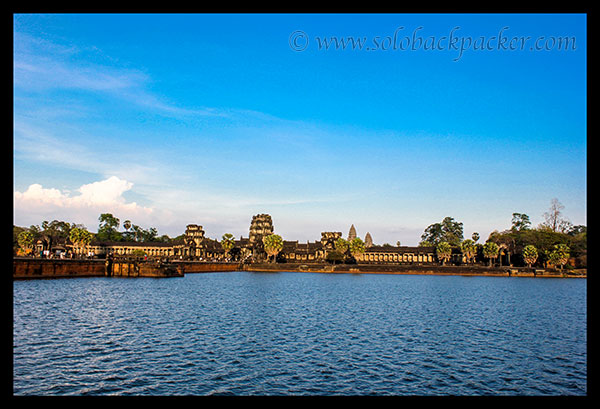
That also ended my three-day amazing bicycle trip to Angkor Archaeological Park.The heart felt heavy because of the thought of leaving that wonderful city next morning, but there was no choice. and Then there were lot of twists still pending in that night. I was almost ready to trap in a No Man’s Land, but that story is for a different post. Next day, I finally left Siem Reap and went to Phnom Penh.


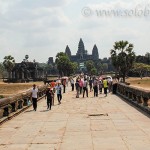
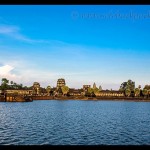
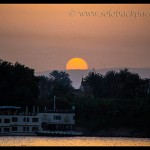
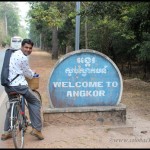
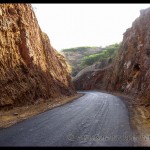

Hi,
Thank you for the detail bicycle trip to each temple. I am about to go Siem Reap next month, and I have some question with regards to bicycle.
1.When you mentioned you parked your bicycle somewhere, I assume you walked around the temple or climb the stairs to have a better view. Is it safe to park the bicycle there? You just use the lock which is provided by the rental shop right?
2. On day 1 especially, when you ride back to your hotel, which is late night, is the road lit? Do we need to bring along some portable torchlight or those flashing red lights for bicycle, so that motorist can see there is bicycle ahead of them? Is it safe to ride at night alone the road?
3. On day 3, where you watch the sunset and then you left the park which i believed it has turn dark. Can you still see the road properly?
Thank you in advance.
Regards.
MF from Singapore
Hi,
Please find your answers:
1. Yes. It’s perfectly safe to park the bicycle at the entrance and it’s good to lock. One day, I forgot the key, so everywhere, I asked the guards to keep a watch on that and it was perfectly fine.
2. No. It was completely dark on the road. The light was installed on my bicycle, but it was an inadequate measure. If you want to ride after the dark, its better to have a powerful headlamp. It’s not safe to ride alone after the sunset. Road condition in some areas are really pathetic and it is not safe otherwise also.
3. Phnom Bakheng is the best place to watch the sunset in the evening. Its near to the main Angkor Wat Temple. But since, it was very crowded, I did not go on the Bakheng Hill, rather I watch the sunset from the Angkor Wat Temple only. It was again pitch dark, while returning back to the town. and the roads are not lit up there. You have to rely on the headlights of the other cars/tuktuks for the light. Else, as suggested earlier, carry a powerful head lamp.
Thank you for the inofrmation.
Hi,
It is a very nice article and I enjoyed reading it. I have a question…which month will be best to visit Angkor Wat with no rain? Since I am planning for a study trip,I should not struck with rain. I am planning to visit this December. Is December be good for visit?
Thank you,
Hi,
You can go there anytime after the September, that is the end of Rainy season. December is one of the best month to visit Angkor Wat. From March onwards, weather will be hot till the end of the June, unbearable during the day time in May and June.